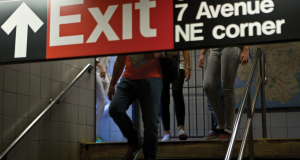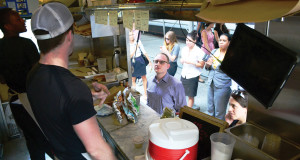Follow this dinner guide as your compass in New York.
“Sleep on the floor if you have to. Find out how other people live and eat and cook. Learn from them–wherever you go.”
–Anthony Bourdain
Red Rooster Harlem
310 Lenox Ave.
For an enchanting atmosphere and exotic soulful grub, saunter in to the legendary Red Rooster Harlem, where the adherence to tradition, experimentation and style revives the spirit of the Harlem Renaissance.
Around the block from Harlem’s historic landmarks such as the Apollo Theater, where the Ella Fitzgeralds and James Browns made their start, a rustic and chic soul food bistro transports you right to that era by serving up some of Upper Manhattan’s most soulful food with international flair.
Named for the legendary speakeasy where students and leaders of the African American elite sojourned, the restaurant has a menu that pays homage to the neighborhood’s renown as the epicenter of African American culture while introducing flavors from culinary canons of regions beyond. Rife with Southern comfort staple sides such as corn bread and collard greens, Red Rooster also sets the scene for Harlem’s diverse future with dishes combining the best of Creole, Asian and Swedish cuisines.
Red Rooster Harlem is the brainchild of superstar chef Marcus Samuelsson, whose ascension into the culinary world began, emblematically, with a diverse personal history. Born in Ethiopia but raised in Sweden, Samuelsson imbues his multicultural narrative into the food and his vision of Red Rooster as a nouveau Harlem establishment. Marrying traditional African American fare with contemporary flavors representing the emergent faces of Harlem, Samuelsson is helping to shape American cuisine. In an entry from Samuelsson’s prolific blog, the chef explains why he’s included unlikely dishes such as chop suey or foods that aren’t traditionally associated with Harlem.
“Food is the best way to understand the soul of a place and I wanted this menu to reflect everything I had absorbed in the years spent living here, cooking and eating everything delicious this neighborhood had to offer,” writes Samuelsson. “These dishes included not only chop suey from a growing Chinese population in the east, but also the delicacies of the Senegalese, West Indian and Latin American communities that overlap on these few city blocks.”
On the sweltering July night when I stepped into the restaurant, my companions and I awaited for our 10:30 p.m. reservation at the half-circle bar, where the warm glow and dapper bartenders encouraged us to indulge in their signature drinks. The “Earl of Harlem” ($15), a sultry whiskey cocktail infused with Earl Grey tea and spiced coriander syrup, quenched our throats with a refreshing kick. A strike of a lighter and a deft flick of the wrist lighted the cocktail aflame, condensing the flavors and creating a spectacle and a memorable distilled beverage. Unable to contain our hunger, we ordered a plate of deviled eggs (worth the $7 because it used chicken skin mayonnaise, adding a deep savoriness to the eggs) and chili cucumbers ($4).
The chili cucumbers — a So-Co interpretation of Korean kimchi — were a harbinger for the other unexpectedly multicultural items on the menu. Past the fried chicken and waffle ($16) and fish and grits ($28) were the Rooster Noodles ($28; pork belly, crab, head-on shrimp, teff ramen), which combined the best of Creole and pan-Asian flavors. When it arrived at our table, it wafted of just that: creole surf with pan-Asian turf. The miso-infused broth burst with surprising harmony with the Cajun-sprinkled shrimp heads.
Aside from the food, Rooster Harlem ranks among one of the best places in the city to people-watch. Men in bowties, three-piece suits and fedoras filled the scene with women in dresses; reminiscent of well-dressed flappers of the roaring ’20s. I took a cue from this regular, who welcomed my nosy admiration of his attire with a smile before sauntering downstairs to Ginny’s Supper Club, a modern-day speakeasy and the Rooster’s sister establishment.
Red Rooster also provides some of the best-curated themed nights, featuring some of the best musicians and DJs from the neighborhood. From “World Beat Wednesdays” to “Rare Grooves Saturdays,” there’s never a dull note from the speakers. For the serious music aficionado, Ginny’s Supper Club provides an excellent lineup of soul, gospel and jazz performances.
True to Samuelsson’s vision, Red Rooster not only preserves its cultural legacy as a Harlem landmark, but also paves its way as a trendsetter in the neighborhood’s future as a culinary, health and cultural hub of Upper Manhattan. Those wanting a quick and wallet-saving bite can drop by the Nook, at the front of the store, where items can be ordered a la carte. Venture uptown to this thriving bloc — the glowing rooster sign, the thumping lounge music, and the dapper patrons will be sure to lure you in.
Cafe Mingala
1393 2nd Ave.
Cafe Mingala has a reputation as one of Manhattan’s quietest, most authentic places to get Burmese grub.
Camouflaged quietly along a row of other East Asian eateries, Cafe Mingala makes its mark not by its exterior, but by its colorful walls and hearty portions of vibrantly spiced dishes. It showcases a rich amalgam of Indian, Chinese and Thai fare. Inexperienced Burmese food eaters won’t have to scan too deeply into the menu to find enticing appetizers such as the Golden Triangles ($4.50; curried potatoes in a crispy triangle shell) or succulent entrees such as Basil Prawn ($16.95). Spice levels vary with each dish.
For gourmands yearning for a deeper taste of Myanmar, Cafe Mingala’s Mohinga ($9.95), Burma’s unofficial national dish, packs a fragrant punch with Thai rice noodles, minced fish, lemon grass, a hard-boiled egg, seeped in a savory, light, citrusy fish broth. The Rangoon Night Market Noodles ($9.95), named for a market in Burma, has tender boiled duck and is sure to evoke a vicarious journey to the bustling nightscapes of that country. The restaurant’s wall murals depict Burma’s bustling pagoda-laden areas and serene riverside landscapes.
End your visit with the Thousand Layered Bread in Sweet Coconut Milk ($5) — the perfect combination of flaky and chewy bread marinated in sweet coconut nectar. Think: baklava meets naan, dunked in rich coconut milk.
If you’re looking for a no-nonsense, satisfying experience, Café Mingala will not disappoint as an Upper West-Side go-to destination. Just as the Burmese would greet one another with “mingalar bar,” this restaurant will compel you to return to say hello again.
Ramen Misoya
129 Second Ave.
A scent from home I often crave the most is the savory aromatics of a good bowl of ramen.
A dish that was traditionally co-opted from the Chinese lo mein, Japanese ramen has been a staple of that culture since the 1920s. Its popularity as a quick and filling meal — and among a younger cohort, a miracle hangover cure — has made it into a ramen museum in Tokyo, and, luckily for me, the streets of St. Marks in the Lower East Side. As a long-time ramen aficionado and a proselytizer of its correct pronunciation (it’s rah-men, not ray-man), I wanted to find the most authentic bowl of ramen I could find in New York City’s mecca for Japanese cuisine.
The first sign of a good ramen joint is a line leading out from a small and narrow establishment. Ramen Misoya passes that test, but if you arrive during happy hour (5-7 p.m.), you’ll beat all traffic. Ramen Misoya also passed the menu test as the options were listed in English and in (accurate) Japanese. Finally, the place wafted of savory broths and their signature cha-shu (braised pork) cuts.
What’s particularly striking about Ramen Misoya is in its name: It’s the first place in the city to specialize in serving miso ramen. Misoya uses three types of miso (a mixture of soybeans and barley) to flavor their stocks. Customers can choose between kome miso (rice-based miso, commonly consumed in eastern Japan), mame miso (red miso, from the southwestern region), and shiro miso (white miso, consumed all over the country). The restaurant also serves seasonal ramen dishes; tackle the heat with the Hiyashi Chūka ($13.80) a chilled dish with a refreshing sesame-infused chili broth dressed with cha-shu and summer veggies.
A hearty bowl of ramen is often accompanied by sizzling plate of gyoza ($4.50 for a plate of six), and Misoya delivers with its homemade pork choice. The minced garlic leaves insert a bitter, yet addictive note to the bite-size dumplings. Other staple appetizers include a small bowl of cha-han ($4), or fried rice, to top off your experience.
Perhaps the highest authenticity point at Misoya is the large TV mounted toward the back of the restaurant, showing a live feed of the chefs at work. Misoya virtually replicates what is common in the prototypical ramen shop: an intimate proximity to the steam emerging from the boiling noodles and brewing broths coming from the kitchen. Only Misoya’s stream tantalizes appetites without feeling the heat emanating from the kitchen — an on-screen preview of your meal.
A List of Authentic Fare: Brooklyn Edition
Coco Roco
139 Smith St.
Authentic Peruvian tapas across from the Bergen Street subway stop in Brooklyn. Great for dates, families or birthdays.
Must Try: The sweet potatoes (you can order them as a appetizer).
Pok Pok NY
127 Columbia St.
Coined as one of the top 20 most important restaurants in America by Bon Appetit, this small restaurant serves probably the most authentic Thai cuisine in the city.
Must Try: Everything. Some of the best cocktails the city has to offer, too.
Talde
369 Seventh Ave.
Truly a melting pot of flavors, Talde defines “fusion” and “amalgam” with its incredibly intertwined Asian American dishes.
Must Try: Korean fried chicken (spicy kimchee yogurt, peaches and mint).
 VOICES Publishing from the AAJA National Convention
VOICES Publishing from the AAJA National Convention






